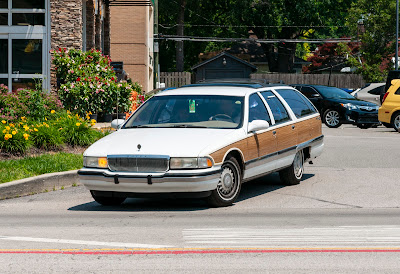The Electra 225 came in three trim levels: regular, Custom, and Limited. We've seen a 1969 Buick Electra 225 Limited here before, in the shape of a Twilight Blue hardtop sedan. The one in this post, on the other hand, is an Antique Gold sport coupe with a Buckskin vinyl roof.
The '69 models have the side marker lights as required by the FMVSS regs of 1968, but in a slightly different location to the ones on a '68 model. It's got the classic Buick styling cues: the chrome "sweepspear" running down the flank and the row of four chrome Ventiports on the front fenders, allowing you to lord it over LeSabre drivers with their mere three.
Under the hood was Buick's 430-cube big block V-8, making 360 SAE gross horsepower and backed by a TH-400 three-speed automatic. Standard final drive was 2.78:1, with a 2.56:1 Economy rear end, as well as 3.08:1 and 3.23:1 options available. There was also a 3.90:1 optional final drive with a mandatory A/C delete. That must have made some noise at freeway speeds.
The bottom photo was taken with a Canon EOS 1D Mark IV and EF 24-105mm f/4L IS zoom lens in August of 2022, while the upper one was taken in June of 2025 using a Canon EOS R and an RF 24-105mm f/4-7.1 IS zoom lens .



























